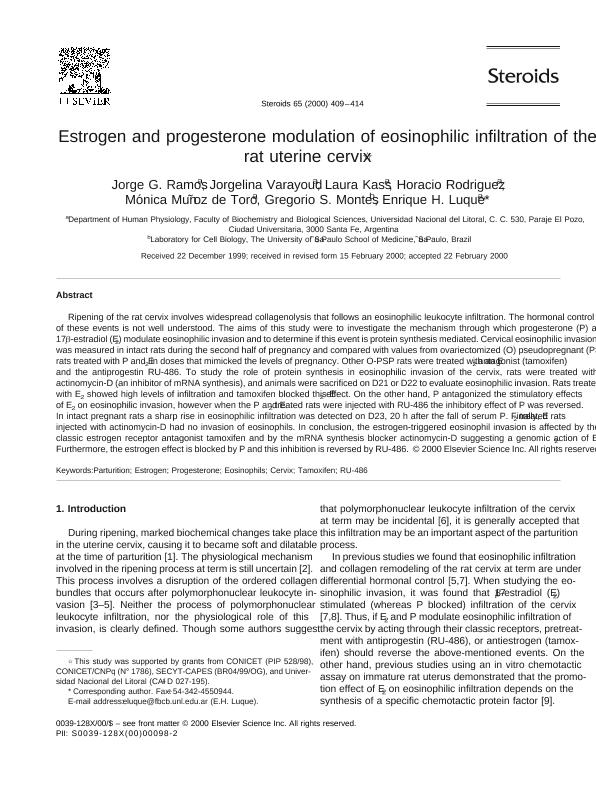Mostrar el registro sencillo del ítem
dc.contributor.author
Ramos, Jorge Guillermo

dc.contributor.author
Varayoud, Jorgelina Guadalupe

dc.contributor.author
Kass, Laura

dc.contributor.author
Rodriguez, Horacio Adolfo

dc.contributor.author
Muñoz de Toro, Monica Milagros

dc.contributor.author
Montes, Gregorio S.
dc.contributor.author
Luque, Enrique Hugo

dc.date.available
2019-03-19T20:00:52Z
dc.date.issued
2000-07
dc.identifier.citation
Ramos, Jorge Guillermo; Varayoud, Jorgelina Guadalupe; Kass, Laura; Rodriguez, Horacio Adolfo; Muñoz de Toro, Monica Milagros; et al.; Estrogen and progesterone modulation of eosinophilic infiltration of the rat uterine cervix; Elsevier Science Inc; Steroids; 65; 7; 7-2000; 409-414
dc.identifier.issn
0039-128X
dc.identifier.uri
http://hdl.handle.net/11336/72044
dc.description.abstract
Ripening of the rat cervix involves widespread collagenolysis that follows an eosinophilic leukocyte infiltration. The hormonal control of these events is not well understood. The aims of this study were to investigate the mechanism through which progesterone (P) and 17β-estradiol (E2) modulate eosinophilic invasion and to determine if this event is protein synthesis mediated. Cervical eosinophilic invasion was measured in intact rats during the second half of pregnancy and compared with values from ovariectomized (O) pseudopregnant (PSP) rats treated with P and E2 in doses that mimicked the levels of pregnancy. Other O-PSP rats were treated with an E2 antagonist (tamoxifen) and the antiprogestin RU-486. To study the role of protein synthesis in eosinophilic invasion of the cervix, rats were treated with actinomycin-D (an inhibitor of mRNA synthesis), and animals were sacrificed on D21 or D22 to evaluate eosinophilic invasion. Rats treated with E2 showed high levels of infiltration and tamoxifen blocked this E2 effect. On the other hand, P antagonized the stimulatory effects of E2 on eosinophilic invasion, however when the P and E2 treated rats were injected with RU-486 the inhibitory effect of P was reversed. In intact pregnant rats a sharp rise in eosinophilic infiltration was detected on D23, 20 h after the fall of serum P. Finally, E2 treated rats injected with actinomycin-D had no invasion of eosinophils. In conclusion, the estrogen-triggered eosinophil invasion is affected by the classic estrogen receptor antagonist tamoxifen and by the mRNA synthesis blocker actinomycin-D suggesting a genomic action of E2. Furthermore, the estrogen effect is blocked by P and this inhibition is reversed by RU-486. Copyright (C) 2000 Elsevier Science Inc.
dc.format
application/pdf
dc.language.iso
eng
dc.publisher
Elsevier Science Inc

dc.rights
info:eu-repo/semantics/openAccess
dc.rights.uri
https://creativecommons.org/licenses/by-nc-sa/2.5/ar/
dc.subject
Cervix
dc.subject
Eosinophils
dc.subject
Estrogen
dc.subject
Parturition
dc.subject
Progesterone
dc.subject
Ru-486
dc.subject
Tamoxifen
dc.subject.classification
Fisiología

dc.subject.classification
Medicina Básica

dc.subject.classification
CIENCIAS MÉDICAS Y DE LA SALUD

dc.title
Estrogen and progesterone modulation of eosinophilic infiltration of the rat uterine cervix
dc.type
info:eu-repo/semantics/article
dc.type
info:ar-repo/semantics/artículo
dc.type
info:eu-repo/semantics/publishedVersion
dc.date.updated
2019-03-18T14:44:50Z
dc.journal.volume
65
dc.journal.number
7
dc.journal.pagination
409-414
dc.journal.pais
Estados Unidos

dc.journal.ciudad
Nueva York
dc.description.fil
Fil: Ramos, Jorge Guillermo. Consejo Nacional de Investigaciones Científicas y Técnicas. Centro Científico Tecnológico Conicet - Santa Fe; Argentina. Universidad Nacional del Litoral. Facultad de Bioquímica y Ciencias Biológicas; Argentina
dc.description.fil
Fil: Varayoud, Jorgelina Guadalupe. Consejo Nacional de Investigaciones Científicas y Técnicas. Centro Científico Tecnológico Conicet - Santa Fe; Argentina. Universidad Nacional del Litoral. Facultad de Bioquímica y Ciencias Biológicas; Argentina
dc.description.fil
Fil: Kass, Laura. Consejo Nacional de Investigaciones Científicas y Técnicas. Centro Científico Tecnológico Conicet - Santa Fe; Argentina. Universidad Nacional del Litoral. Facultad de Bioquímica y Ciencias Biológicas; Argentina
dc.description.fil
Fil: Rodriguez, Horacio Adolfo. Consejo Nacional de Investigaciones Científicas y Técnicas. Centro Científico Tecnológico Conicet - Santa Fe; Argentina. Universidad Nacional del Litoral. Facultad de Bioquímica y Ciencias Biológicas; Argentina
dc.description.fil
Fil: Muñoz de Toro, Monica Milagros. Universidad Nacional del Litoral. Facultad de Bioquímica y Ciencias Biológicas; Argentina
dc.description.fil
Fil: Montes, Gregorio S.. The University of São Paulo School of Medicine; Brasil
dc.description.fil
Fil: Luque, Enrique Hugo. Consejo Nacional de Investigaciones Científicas y Técnicas. Centro Científico Tecnológico Conicet - Santa Fe; Argentina. Universidad Nacional del Litoral. Facultad de Bioquímica y Ciencias Biológicas; Argentina
dc.journal.title
Steroids

dc.relation.alternativeid
info:eu-repo/semantics/altIdentifier/url/https://linkinghub.elsevier.com/retrieve/pii/S0039128X00000982
dc.relation.alternativeid
info:eu-repo/semantics/altIdentifier/doi/https://doi.org/10.1016/S0039-128X(00)00098-2
Archivos asociados
